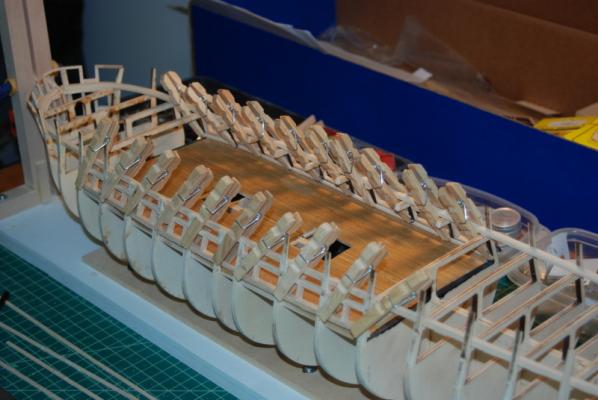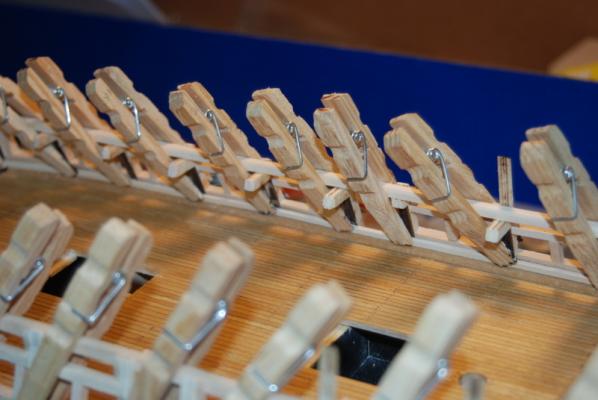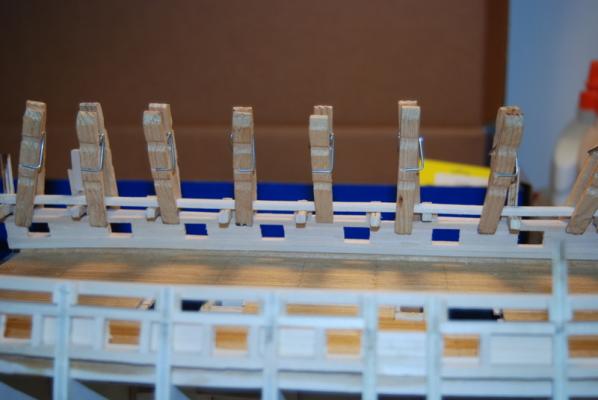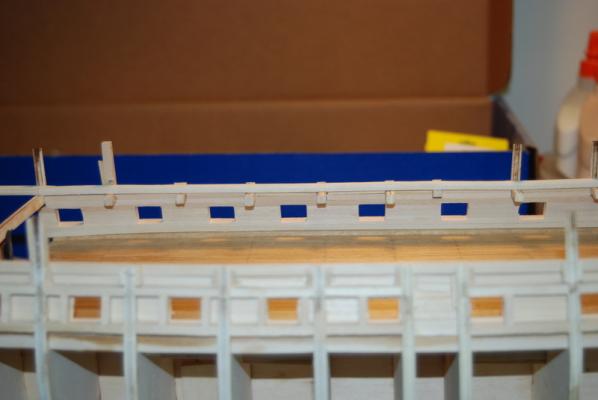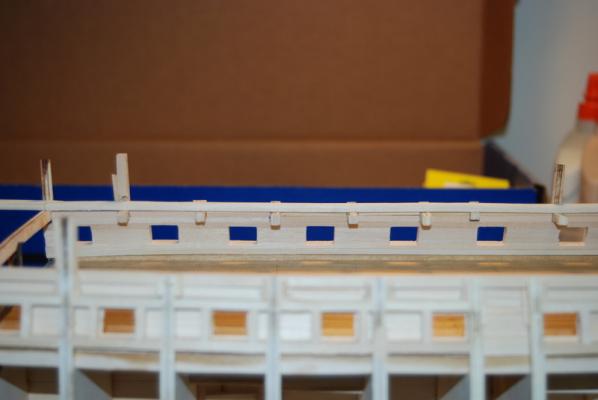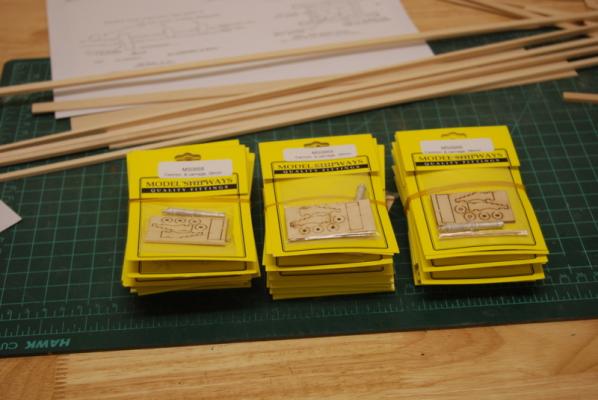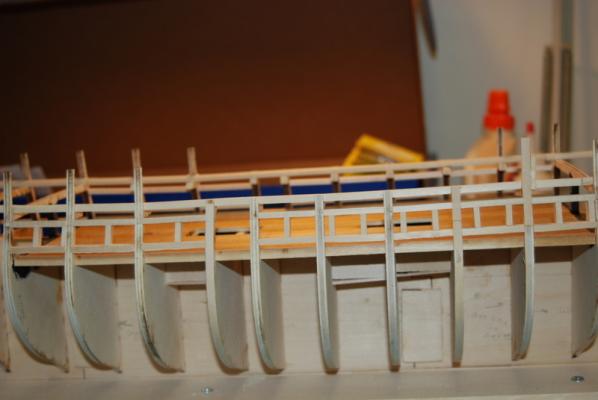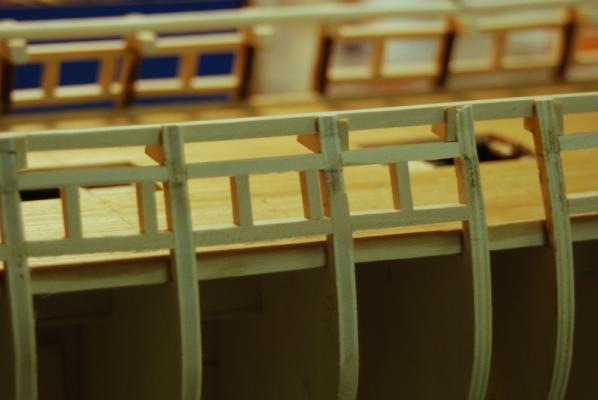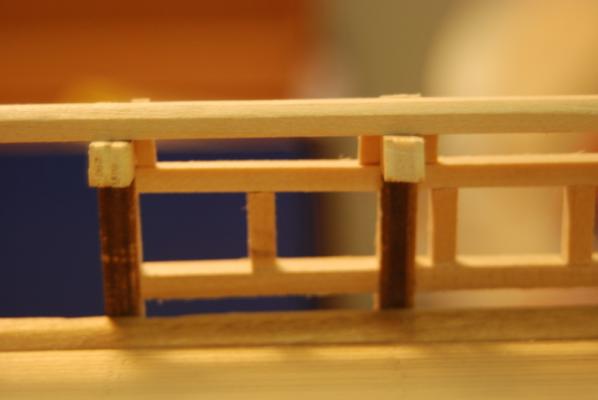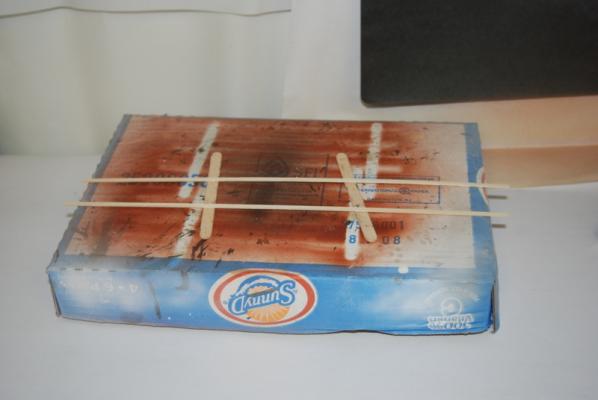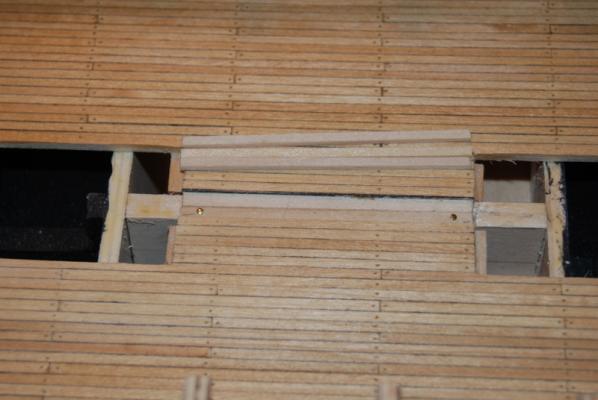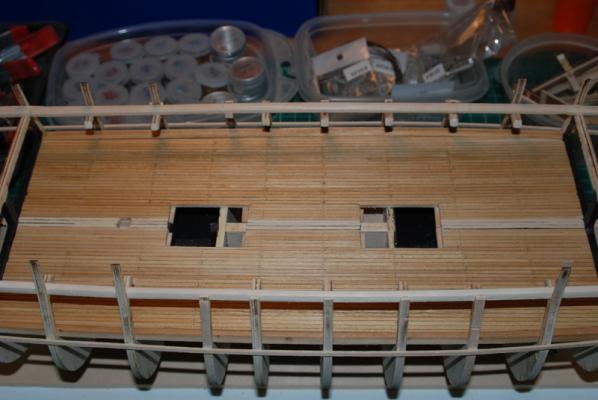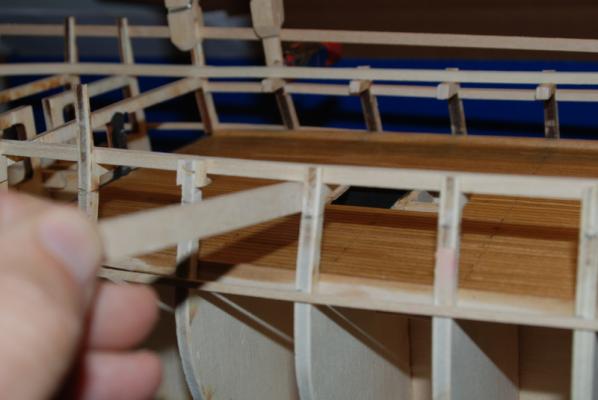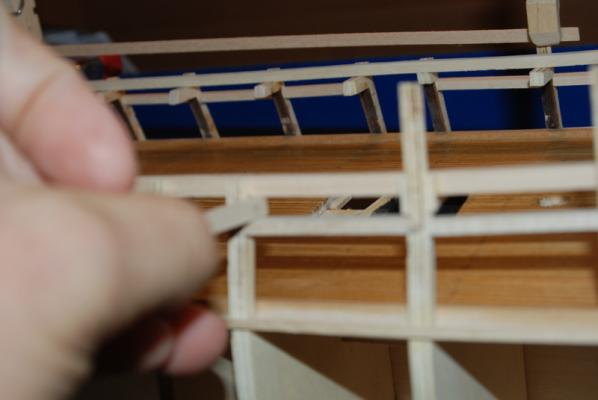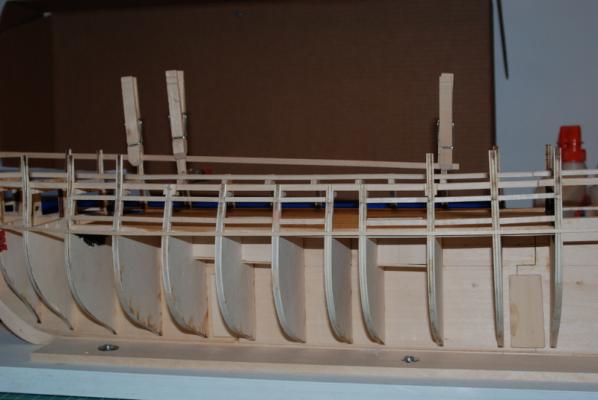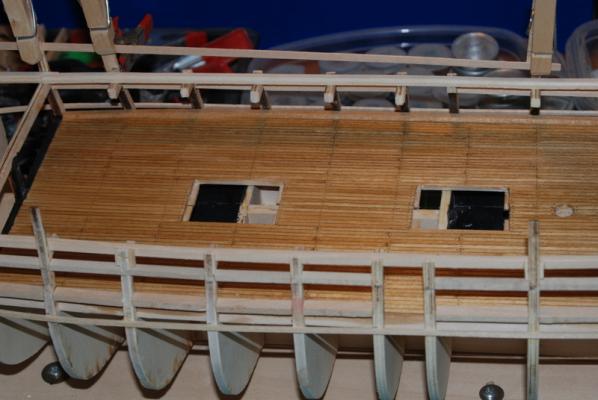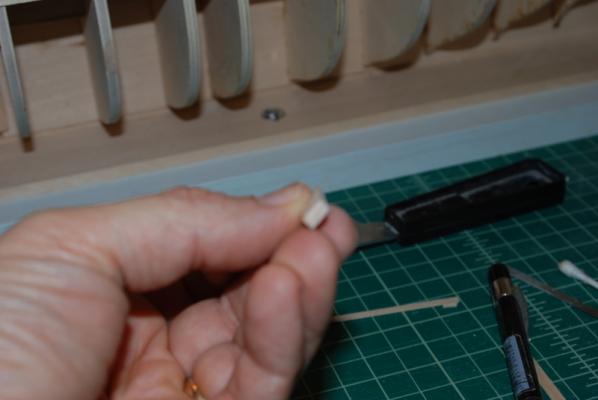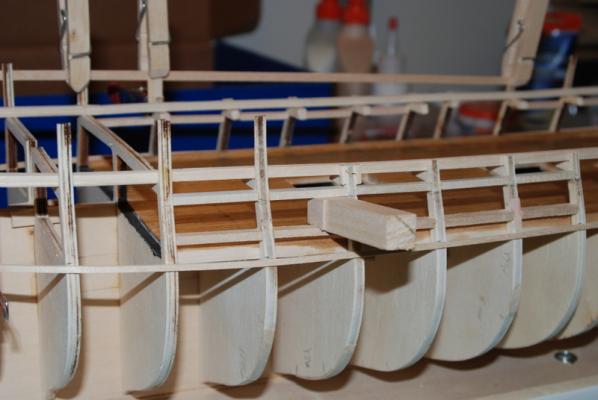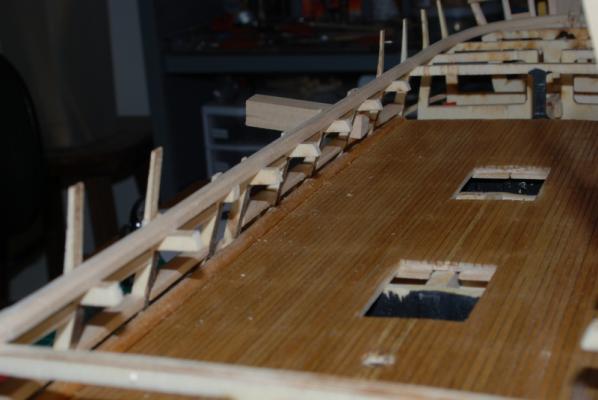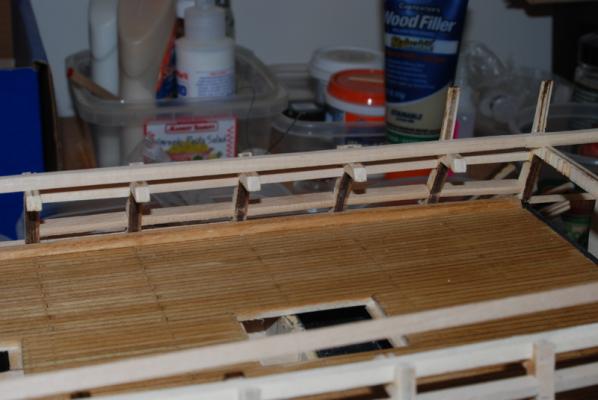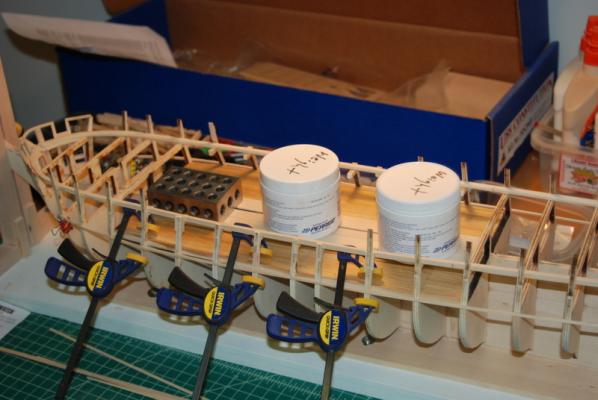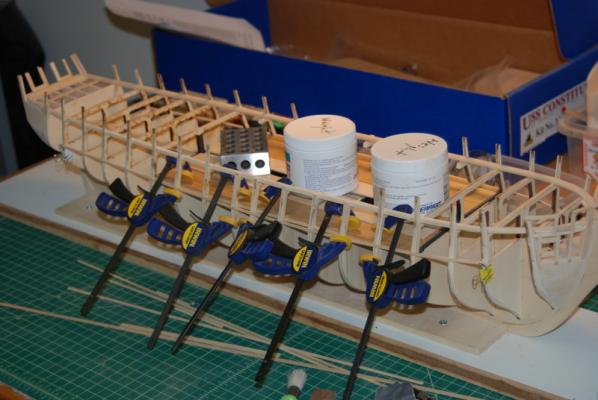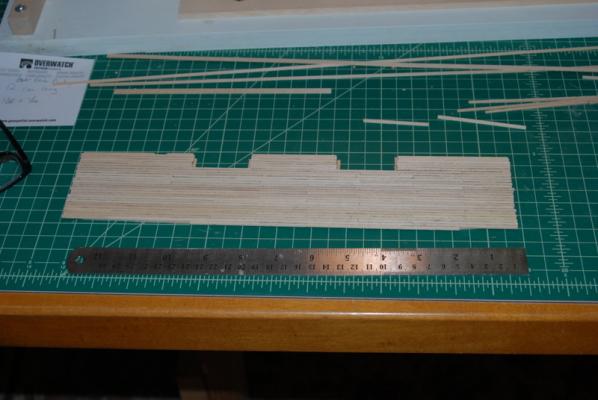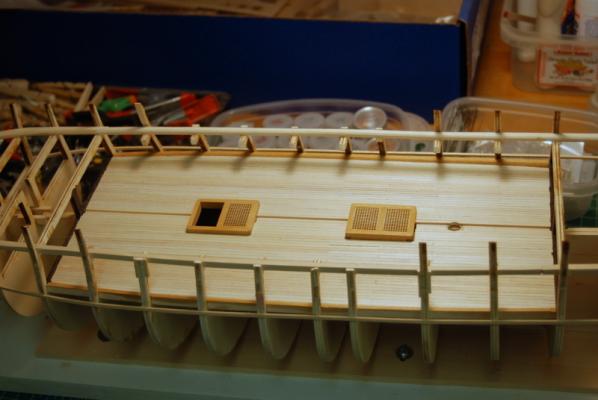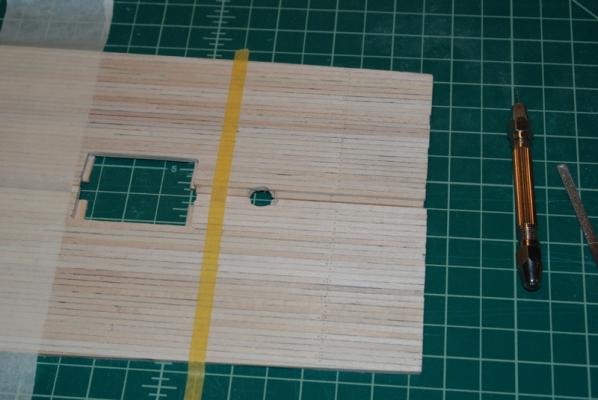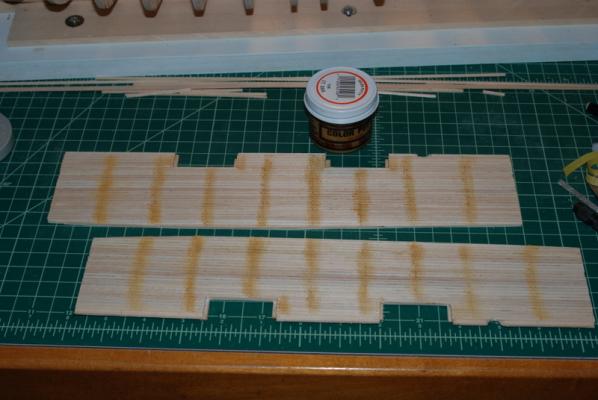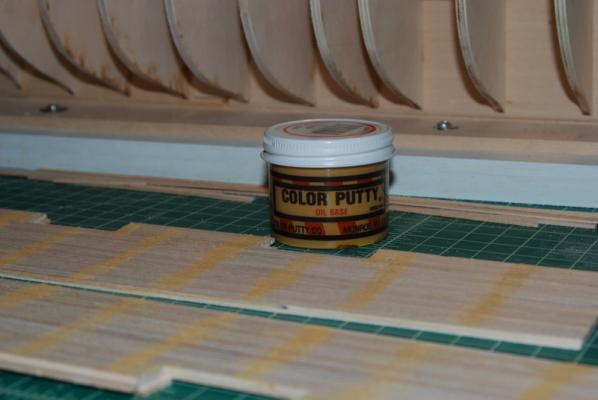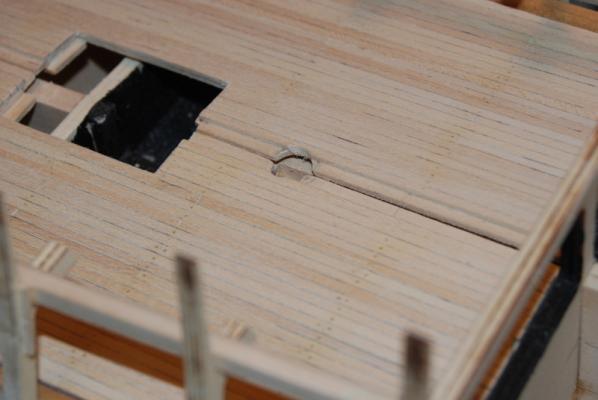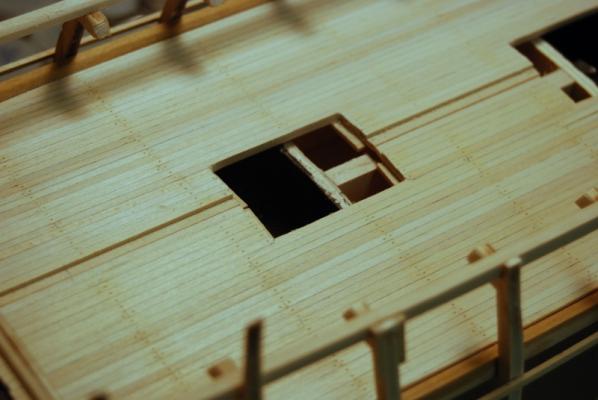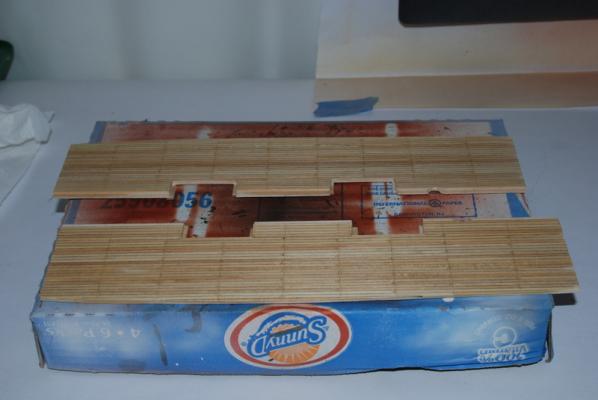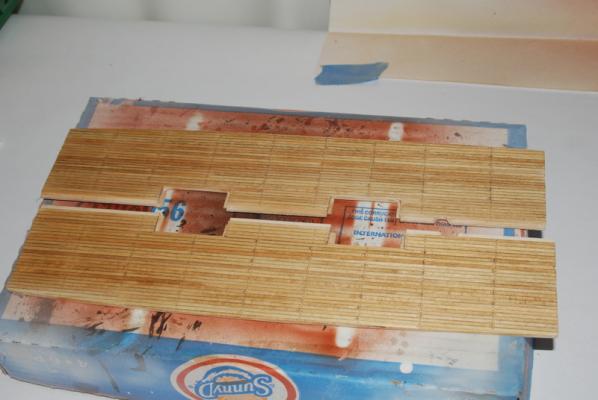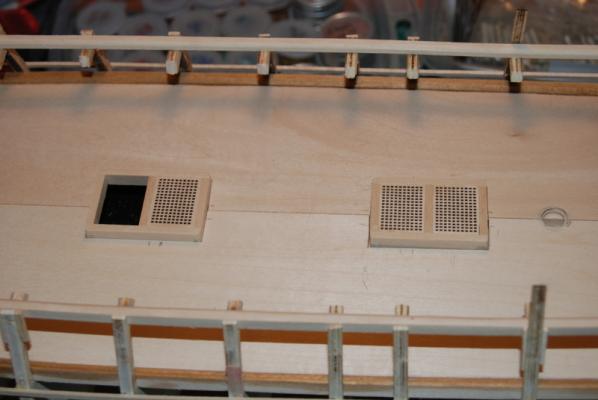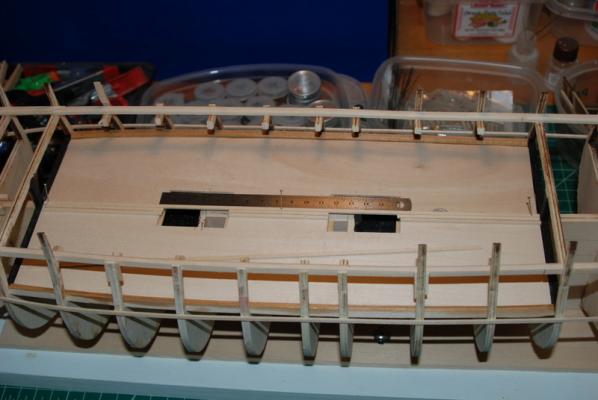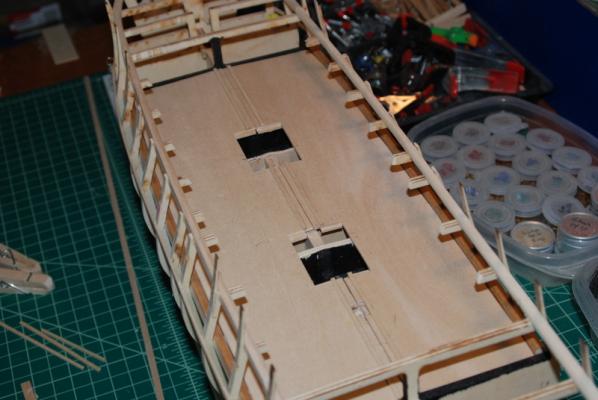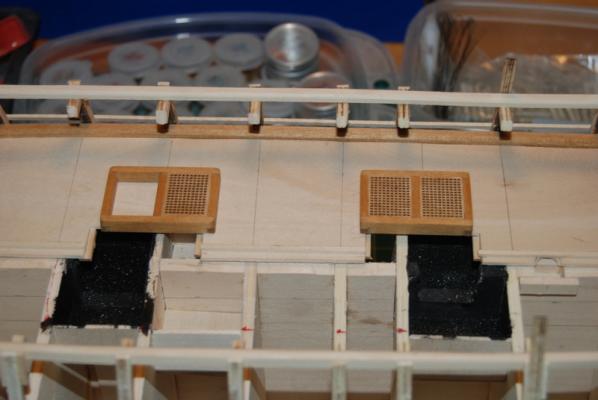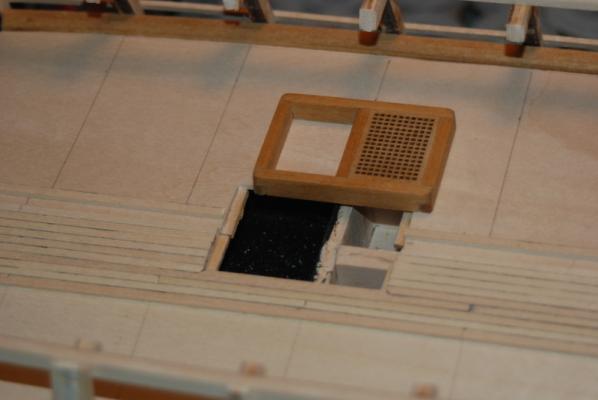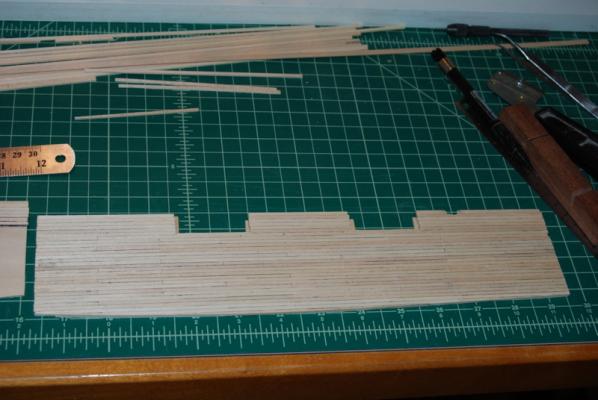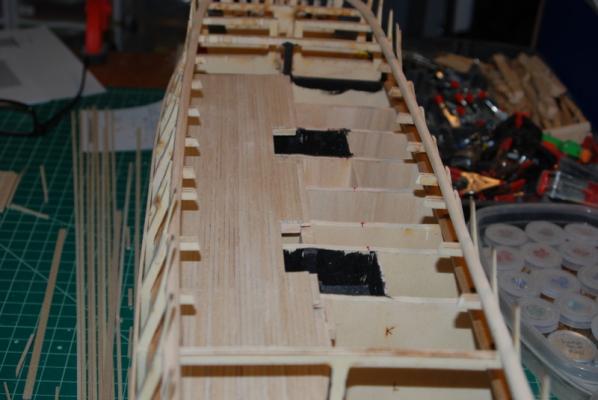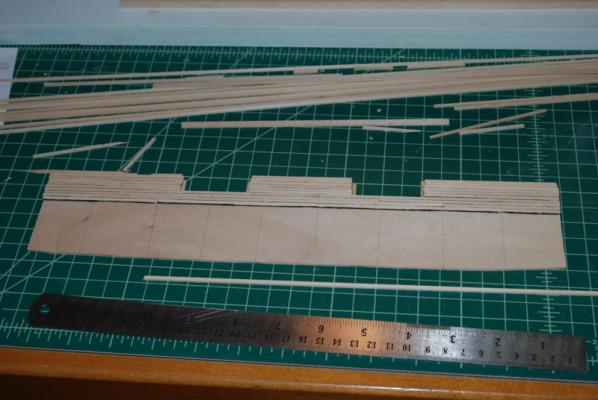-
Posts
2,418 -
Joined
-
Last visited
Content Type
Profiles
Forums
Gallery
Events
Everything posted by usedtosail
-
Here are a couple of updates. I'll show the interior wall planking of the gun deck in this one and the experiments with the gun deck cannons in the next one. I planked the insides of the gun deck walls using the same 1/8" by 1/16" planks that I used for the deck planking. I started with two full length planks at the bottom of each side. I mixed up some off white paint and painted the bottom planks before installing them, although the color looks very similar to the basswood itself. Those clothes pins held the planks very nicely in place while the glue dried. I then cut three short planks for between each of the gun ports and glued them in. I made them slightly longer than the span between the gun ports and will clean up the gun port openings later. These plank ends will be flush with the gun port openings, where as the outside hull planks will leave a slight gap for the gun port lids to fit in. The next plank up was a full length plank, then I had to make shorter planks with either notches for the deck beam ends or cut to fit between the deck beam ends. I ended up gluing the upper planks directly to the edges of the planks below. I really did not need the little supports I added for these planks before, as they really didn't support them. I did add a thin strip from the outside onto these upper planks to tie the top three together to give them a little more strength. These strips will be hidden when the outer hull planking is added. I cleaned up the gun port openings from the outside using some small diamond files, after cutting some of the excess plank ends with an X-Acto knife. I still have a little more cleaning to do from the inside to get the corners more crisp. I only had to do a little sanding of the interior planks, which I did with a riffler file first, then taped some sandpaper to the end of it and used that for the final sanding. Here is how the starboard side interior looks so far.
- 1,350 replies
-
- constitution
- model shipways
-
(and 1 more)
Tagged with:
-
Great job Christi. She came out wonderfully.
- 93 replies
-
- santissima trinidad
- occre
-
(and 2 more)
Tagged with:
-
Wow, I just read through your whole build. That is one sweet looking boat. I might have to add this one to the futures list. I really like your use of decals for the fine details. I noticed you were having trouble with the images for your decals. I recently came across a free program that works like Adobe Illustrator that lets you go from images to vectors and back to images, so you can make changes to the patterns like your circles. It is called Inkscape - I don't have the link in front of me but a google search should bring it up. Thanks for the great build log.
-
Patrick - yes they do look to be good quality. I am going to put one together this weekend to check the fit in the gun ports, so I'll see how good the wood is and how well the carriages fit together. Steve - ha ha. I was lucky to get third. Those other entries were all awesome. I am just glad it was a photo contest.
- 1,350 replies
-
- constitution
- model shipways
-
(and 1 more)
Tagged with:
-
I ordered the cannon package from Model Expo for the gun deck cannons and they came in this week. I only need 16 real cannons for the piece of gun deck I am adding, but the whole package was cheaper than ordering 16 individual cannons, by a lot. Plus, I had two $10 gift certificates from the shipmodeling.net competition (2 third places). I figure I can use the extras for future models, maybe even a scratch build. Here is a comparison of the barrels with the dummy cannons for the other gun ports. They are close but not exactly the same. I have the option of turning the extra real barrels into dummy barrels, but I haven't made that decision yet. What do you think? I completed the gun ports for the real cannons on both sides and sanded the outsides flush with the bulkheads. I also did a little filing on the inside using a riffler file to make sure everything is flush for the inner planks. While doing that inside work, I realized I had a problem with the top of the inside walls, between the deck beams. There was no support for the planks that need to fit between the beams to close off the tops of the walls. After some thinking (probably too much) I came up with this solution, to glue small pieces of wood along each beam side that can support the ends of the planks. In this picture you can see them on the gun port on the right, and not the two on the left. Here is a view from the inside that shows how they will work. They are flush with the insides of the gun port frame at the bottom and with the outside of the spar deck waterway at the top. I am not sure if this is the exact angle they should be, but they are going to be very hard to see, if at all, and I could probably get away with just leaving this area unplanked, but what's the sport in that. Finally, I had to mix some paint for the insides of the gun deck walls and gun ports. I am using an off white that I mixed up from ME's Warm White and Cream. It is almost the same color as the basswood itself, but it adds a different texture to the wood. Here are the first planks for each side, which I pre-painted so I don't get paint on the waterway later. Next is to plank the inside walls of the gun deck.
- 1,350 replies
-
- constitution
- model shipways
-
(and 1 more)
Tagged with:
-
Ok. I'll just sit here in the corner and wait. I am very patient.
- 1,616 replies
-
- caldercraft
- agamemnon
-
(and 1 more)
Tagged with:
-
That planking looks great Sjors. I'll pull up a seat for the rest of this build, for sure.
- 1,616 replies
-
- caldercraft
- agamemnon
-
(and 1 more)
Tagged with:
-
I didn't add stealers, but my shutter plank was too narrow. I made a new one from a sheet of basswood of the same thickness.
- 625 replies
-
- bounty launch
- model shipways
-
(and 1 more)
Tagged with:
-

Contour duplicator
usedtosail replied to Captain Al's topic in Modeling tools and Workshop Equipment
I have seen them used to get the hull curvature of the bottom to make cradles. I bought one for that purpose but have not used it yet. If it was big enough it should work for getting the curve to bend the planks too. -
Thanks Patrick. Outside hull planking is a little ways off yet. The next planking will be the inside walls of the gun deck section, which will be right after these gun ports are framed.
- 1,350 replies
-
- constitution
- model shipways
-
(and 1 more)
Tagged with:
-
After I took the weights off the deck pieces, one side was sticking up a little at the center line, so I fixed it by drilling some holes through the false deck into the center keel and pushing in some small nails. These will be hidden by the center deck planks. Once I had the deck pieces flush, I cut the remaining deck planks to fill the center gap. I sanded the three pieces in each gap until they fit in the space. My hunch was right to make the gap three pieces instead of just one, as the widths all looked consistent this way. If I had to sand just one plank, it would probably have looked too thin. I marked the edges of these planks with the Sharpie and glued them in. After they dried, I sanded them down flush with the rest of the deck, drilled and filled holes for their treenails, gave them a final sanding, and stained them. I then gave the whole deck another coat of stain to blend it all in. Here they are before I sanded them down flush. The finished deck can be seen in later pictures in this post. I started cutting the boards that will make up the tops of the gun ports with the real cannons on the gun deck. I am using the bottom of the waterway as a reference and measured down from it to find the locations of the bottoms of the top boards, using a strip of wood of the correct height as a measuring device. I also used a wood strip to measure down from the waterway to the top of the board. I cut out the boards, sanded them to fit, then used the smaller wood strip measuring device to position them the correct distance from the waterway. For the bottoms of the gun ports, I need to have the inside and outside beveled to match the angle of the bulkheads. The outside I can sand in later, but there is no way to get to the inside, so I beveled the inside edges of these pieces before I glued them in. I used a block of wood that I made to the shape of the gun ports to distance the bottom pieces from the top. Here you can see how the bottom pieces are flush with the inside bulkheads: Wow, there is already a lot of dust on the deck. Sorry for the out of focus pictures. I need more practice taking pictures with one hand. Here is one side of top and bottom gun port framing. I have to wait to finish the other side as you can see that I broke off one of the bulwark supports (again!). I almost lost this one, but found it later on the floor. I am reinforcing them as I glue them back in, probably to no avail. I will be offline for a few days so no updates until next week.
- 1,350 replies
-
- constitution
- model shipways
-
(and 1 more)
Tagged with:
-
Yes Steve, thanks for the tutorial on the wet palette technique. I have filed that one away for later.
- 78 replies
-
- model shipways
- bounty launch
-
(and 1 more)
Tagged with:
-
You don't see too much lilac wood used in these models. I am impressed.
- 2,215 replies
-
Thanks Steve. I hope someone will find this useful. I have to say I have almost as much enjoyment writing about what I have done as I do doing it. It helps me remember what I did when I have to do it again, or in some cases what not to do or what to do better. I am getting to the point in life that I have to write down everything anyway just to remember it. I actually keep a more detailed build log for my builds in a Word document that I refer back to often.
- 1,350 replies
-
- constitution
- model shipways
-
(and 1 more)
Tagged with:
-
Thanks Patrick and Alde. I glued the two deck sections into the hull tonight. I was able to wedge some clamps along the outside edge to hold it down and used weights along the centerline to get the decks to follow the slight curve of the gun deck roundup from side to side. I glued the port piece first, then after a few hours I glued the starboard piece. I had to use a few more clamps on the starboard side. I put some wood strips under the weights so I wouldn't scratch the finish. Those jars are filled with lead flashing. Tomorrow I will fill in the center planks, then it is off to frame the gun ports. I will have 8 real guns and 8 dummy guns on each side.
- 1,350 replies
-
- constitution
- model shipways
-
(and 1 more)
Tagged with:
-
God luck with your new project Jay. It looks very interesting. I will enjoy following along, as I am with your Constitution.
-
Thanks Tim for your very kind words. I finished up the bulk of the gun deck planking last night, except for the three planks that will go down the center over the seam of the two pieces. First, here is the starboard side piece after planking and a first scraping/sanding, but before trimming the edges. After the edges were trimmed and it fit into the hull, here is the two pieces together, after filing out the hatch openings to fit the finished coamings. Now for the treenails. I taped the two sides down on the work table. I had added alignment marks so I could get them to line up outside of the hull. I then used some masking tape to mark each line of butt joints, and drilled one #74 hole in the planks that did not have a joint at that beam. I then took the tape off and drill two holes at each butt joint, one on each side of the joint. I also drilled holes at the ends of the planks at the hatch openings. I did not drill holes at the plank ends on the edges of the deck pieces, as the beam locations at each end are actually just off the pieces. When all the holes were drilled, I filled them with oak putty, which is different than wood filler. It is more oily and stays pliable. It looks horrible when it first goes on though: Here is the putty I am using: I then scraped and sanded the excess putty off. I don't leave it sit on the wood too long, as I think it might stain it after a while. The putty stays in the holes nicely though, which is why I like it better than filler. I then gave the decks a final sanding with medium then fine sandpaper. The first picture is with flash and the second is natural lighting which shows a little more detail: I then pre-stained the decks, after wiping them with a tack cloth. Here is how they look with just the pre-stain: After 15 minutes, I wiped off the excess pre-stain and gave them a coat of oak stain: I am happy with the way they came out, and will use this same finish on the spar deck when I plank that.
- 1,350 replies
-
- constitution
- model shipways
-
(and 1 more)
Tagged with:
-
I am sorry too Keith. He looks like a good friend. It has been a bad week.
- 78 replies
-
- model shipways
- bounty launch
-
(and 1 more)
Tagged with:
-
Sorry Patrick, I don't. I would not count my research on this ship very deep. I have read the AOS book and looked over the plans on the Constitution site. Pretty much everything else came from build logs on this site. I made myself a series of notes as I read them but I did not keep track of which ones came from which sites. Given that, I already know that I am not making an authentic 1812 version. The gun port lids for one. As you have found, they either had full or no gun port lids in 1812. Because I am not building the whole gun deck, I want to use the dummy cannon barrels in those gun ports that won't have a real cannon. These need to have the closed split gun port lids to look good, otherwise you will see too much of the boxing behind them. My other option is to just put a closed full gun port lid on these, but I like the look of the split ones and I want to show all of the cannons sticking out of the gun deck. I hope this isn't too blasphemous, especially on such a well documented ship. Well, really I am surprised how much interpretation is still being done on it.
- 1,350 replies
-
- constitution
- model shipways
-
(and 1 more)
Tagged with:
-
Thanks Patrick. It's nice to have such good friends here. I did manage to get some work done last week and this weekend, so I might as well bring you all up to date. First, here are the hatches to the berth deck completed with the gratings. I used three of the large gratings from the spar deck main hatch cover, which I cut apart. That hatch cover is not needed since the main hatch will be left open with the deck beams showing. I was quite pleased how these gratings cleaned up. This is actually the back side of them, which looked a lot better than the front side. The holes look round on the front side but square on the back. I stained these hatches with oak stain, which you can see in some later pictures. I then started planking the gun deck sections. I first pined a plank down the center as a reference, then put in spacers for another plank width on each side. I then cut and glued in one row of planks against those spacers on each side. These will be the starting planks that all the rest will be based on, so I made sure they were very straight and square. I left a plank on each side of the center plank so that when I put the two planked sections together later, I will have three plank widths to use to make sure there are no gaps in the center of the deck. We will see how this works out later. I drew lines at each of the bulkhead locations for the ends of the planks. I did move the location of the one bulkhead that is very close to its neighbor to be more centered between its neighbors, which is how I will show the deck beams for the spar deck. I have no idea why ME put those two bulkheads so close to each other, unless it has to do with the location of the main hatch (I am at work right now so I don't have the plans in front of me). Here are some pictures of the planking process and the finished hatch coamings and grates: Here is the port side deck section planked, before scraping and sanding. I used a black Sharpie on one edge of each plank as I installed them. I also used a three butt shift pattern. The planks lengths hit every three bulkheads and were nominally 20 cm long. This turns out to be a little long for this scale (~50 feet), but I didn't want to use planks that were shorter. The instructions for the hull planking say to use planks that are 4 bulkheads in length, but that would have been way too long. If you look closely around the hatch openings, you will see that I used wider planks that I cut down away from the hatch but left a little wider around the edge of the hatch. This is similar to what I have seen around gun ports on hull plankings, especially on Chuck's models. If I didn't do this I would have had a very narrow plank along the hatches, which I didn't want. I am not sure if this is authentic, but to me it looks better than a very thin plank. Here is the deck planking after an initial scraping and sanding, but I have not added the treenails yet. And again for symmetry, here is the starboard deck section being planked. You can see how the Sharpie looks before finishing. I do have to be careful not to get any on the plank surface, but if I do, I can turn the plank over and use the other side. Next is to come up with a way to hold these sections tight to the deck beams when I glue them down. I am also doing some trials for treenails, which with these narrow planks could be challenging.
- 1,350 replies
-
- constitution
- model shipways
-
(and 1 more)
Tagged with:
About us
Modelshipworld - Advancing Ship Modeling through Research
SSL Secured
Your security is important for us so this Website is SSL-Secured
NRG Mailing Address
Nautical Research Guild
237 South Lincoln Street
Westmont IL, 60559-1917
Model Ship World ® and the MSW logo are Registered Trademarks, and belong to the Nautical Research Guild (United States Patent and Trademark Office: No. 6,929,264 & No. 6,929,274, registered Dec. 20, 2022)
Helpful Links
About the NRG
If you enjoy building ship models that are historically accurate as well as beautiful, then The Nautical Research Guild (NRG) is just right for you.
The Guild is a non-profit educational organization whose mission is to “Advance Ship Modeling Through Research”. We provide support to our members in their efforts to raise the quality of their model ships.
The Nautical Research Guild has published our world-renowned quarterly magazine, The Nautical Research Journal, since 1955. The pages of the Journal are full of articles by accomplished ship modelers who show you how they create those exquisite details on their models, and by maritime historians who show you the correct details to build. The Journal is available in both print and digital editions. Go to the NRG web site (www.thenrg.org) to download a complimentary digital copy of the Journal. The NRG also publishes plan sets, books and compilations of back issues of the Journal and the former Ships in Scale and Model Ship Builder magazines.


